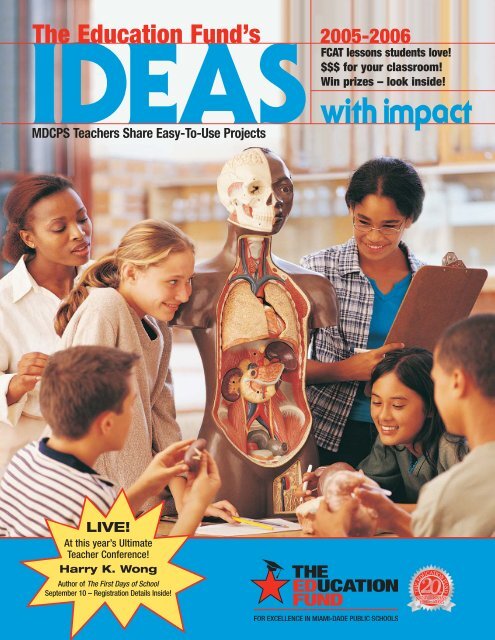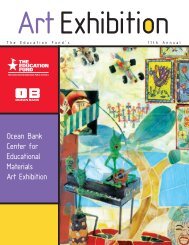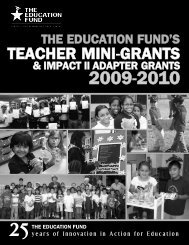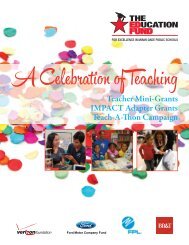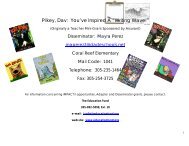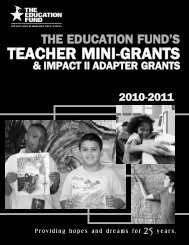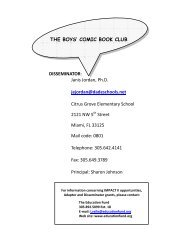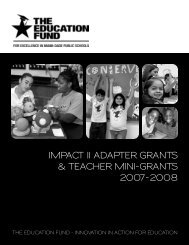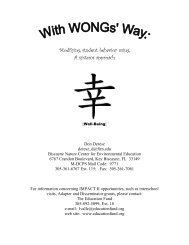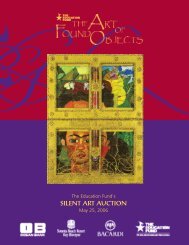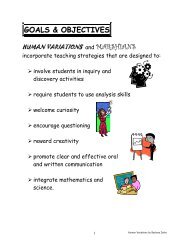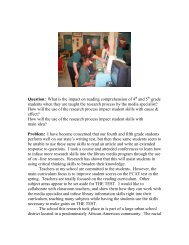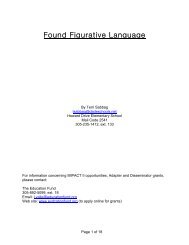2005-06 Ideas with IMPACT Catalog - The Education Fund
2005-06 Ideas with IMPACT Catalog - The Education Fund
2005-06 Ideas with IMPACT Catalog - The Education Fund
- No tags were found...
You also want an ePaper? Increase the reach of your titles
YUMPU automatically turns print PDFs into web optimized ePapers that Google loves.
6Easy Ways to Help<strong>The</strong> <strong>Education</strong> <strong>Fund</strong>1. Buy an <strong>Education</strong> License Plate! <strong>The</strong> <strong>Education</strong><strong>Fund</strong> receives $20 from the sale of eacheducation license plate sold in Miami-DadeCounty – and from renewals each year! (Seepage 15 of the insert for more information.)2. Designate <strong>The</strong> <strong>Education</strong> <strong>Fund</strong> as the recipientof your United Way contribution. Just fillout your United Way contribution card andwrite in <strong>The</strong> <strong>Education</strong> <strong>Fund</strong> as your donationrecipient. It’s that simple!3. Honor a loved one by making a donation to<strong>The</strong> <strong>Education</strong> <strong>Fund</strong> in their name.4. Designate <strong>The</strong> <strong>Education</strong> <strong>Fund</strong> as a beneficiaryin your will.5. Give a donation of stock or property to <strong>The</strong><strong>Education</strong> <strong>Fund</strong>.6. Make a cash donation or use your creditcard on our secure Web site: logon towww.educationfund.org and click“Donate now!”Call <strong>The</strong> <strong>Education</strong> <strong>Fund</strong> today (305-892-5099, ext. 21) to find outhow you can make charitable giving a part of your portfolio.THE EDUCATION FUND900 NE 125th St., Suite 110 • North Miami, FL 33161 • 305-892-5099 (phone) • 305-892-5096 (fax)www.educationfund.org<strong>The</strong> <strong>Education</strong> <strong>Fund</strong> Board of DirectorsOfficers: Gary M. Pappas, Carlton Fields • Barbara L. Romani, Citibank FSB • George Torres, <strong>The</strong> Miami Herald/El Nuevo Herald • Nelly Rubio,WFOR-TV/CBS4/UPN33 • Roland B. Garcia, Sr., Original Impressions, LLC • Lisa Sloat • Barbara Ehrich Locke, Holland & Knight • Linda Lecht,<strong>The</strong> <strong>Education</strong> <strong>Fund</strong> • Directors: Karen Aronowitz, United Teachers of Dade • Steve S. Baker, Esq., Miami-Dade County Aviation Department• Brenda Bassett, Cefalo’s Wine Cellar • Frank J. Bolaños, <strong>The</strong> School Board of Miami-Dade County • Rudolph F. Crew, Ed.D., Miami-DadeCounty Public Schools • Scott Deutsch, Orange Clothing Company • Ben Gentile, Washington Mutual • Nelson Gonzalez, Esslinger WootenMaxwell, Inc. Realtors • Joel Grossman, Tourism Solutions • Fedrick Ingram, <strong>2005</strong> MDCPS Teacher of the Year • Betsy H. Kaplan • Teresa KingKinney, Realtor Association of Greater Miami & the Beaches • Patricia Lefebvre, BankAtlantic • Ana Rivas Logan, <strong>The</strong> School Board of Miami-DadeCounty • Tony Macias, Royal Caribbean Cruise Lines • Dr. Alex Martinez, <strong>2005</strong> MDCPS Principal of the Year • Kimberly T. Miller, APR, Pollo Tropical• Lucy W. Petrey, Miami Dade College • Hector J. Ponte, Wachovia Bank, N.A. • Ileana Carrera Portal, Ocean Bank • Angela Ramos, Univision23/Telefutura 69 • Daniel Rosenthal, UnitedHealthcare of Florida, Inc. • Mitch Shapiro, Beber Silverstein Group • Merrett R. Stierheim • AdvisoryBoard: Benigno F. Aguirre, Ocean Bank • Luis Ajamil, Bermello, Ajamil & Partners, Inc. • Albert A. Del Castillo, Squire, Sanders & Dempsey • TedA. Fernandez, AnswerThink Consulting Group • Calixto Garcia-Velez, Citibank Florida • Seth Gordon, Gordon Reyes & Company • Evelyn LangliebGreer, <strong>The</strong> School Board of Miami-Dade County • Allen C. Harper, Esslinger Wooten Maxwell, Inc. Realtors • Susan James, Washington Mutual• Dennis M. Klinger, FPL • R. Kirk Landon, <strong>The</strong> Kirk Foundation • Carlos Migoya, Wachovia Bank, N.A. • David Patrick Nixon, Golin/Harris• Benjamine Reid, Carlton Fields • Dale C. Webb, Chapman-Webb • Joanna D. Wragg, APR, Wragg & Casas Public Relations • Carol G. Wyllie,<strong>The</strong> Graham Companies • Dr. Sanford & Dolores Ziff • Pro Bono Consultants: Kevin D. Young, Pricewaterhouse Coopers LLP • Henry R.Raattama, Jr., Akerman, Senterfitt, & Eidson, P.A. • Beber Silverstein Groupwww.educationfund.org1
<strong>The</strong> <strong>Education</strong> <strong>Fund</strong>’s IMPA<strong>IMPACT</strong> II is a program of <strong>The</strong> <strong>Education</strong><strong>Fund</strong> that focuses on strengtheningcurriculum, student achievement andleadership in Miami-Dade County PublicSchools by identifying and connecting teacherswho exemplify professionalism and creativityin their classrooms. This comprehensivenetwork has specially designed programsthat encompass beginning teachers toexperienced teachers through the originalNetwork Model, Teachers Network LeadershipInstitute and the New Teacher Initiative.Network ModelTeachers who have developedsuccessful classroom teachingmethods are given grants to packageand market their proven projectsthrough the <strong>Ideas</strong> <strong>with</strong> <strong>IMPACT</strong>catalog, the Idea EXPO and IdeaPackets that contain curriculummaterials such as lesson plans,worksheets and resource lists.• Disseminator grants help teachersfurther develop and disseminateproven practices they have usedsuccessfully in their own classroom.Apply by Dec.1, <strong>2005</strong>.• <strong>Ideas</strong> <strong>with</strong> <strong>IMPACT</strong> catalog –Explore this resource of newteaching ideas. Projects can beused exactly as they are or can bemodified to meet a classroom’sspecial needs. Contact thedisseminator of the idea formore information.• <strong>The</strong> Idea EXPO – <strong>The</strong> TeacherConference. Get new ideas andmake connections <strong>with</strong> experiencedteachers during the <strong>IMPACT</strong> IIproject display exhibition andworkshop sessions. Special featuresinclude a master teaching session<strong>with</strong> Dr. Harry Wong on classroommanagement, a luncheon andfree curriculum packets.• Adapter grants are available forany project in the <strong>IMPACT</strong> IInetwork of ideas from the past15 years. Just connect <strong>with</strong> theDisseminator of the idea, requestan Idea Packet and receive fundsto implement in your classroom.2www.educationfund.org
Table of ContentsARTS PROJECTS6 All That JazzJanet Duguay Kirsten7 See the World Through a Pinch Pot!Sara Gagliano-AlfaroESE PROJECTS8 W.E.A.V.E. - Weaving <strong>with</strong> EverydayApparel using Varied ElementsDebra GaudetINTERDISCIPLINARY PROJECTS9 Corn Through TimeMinerva Santerre10 Inside AfricaMark RosenkrantzLANGUAGE ARTS PROJECTS11 Collaborate, Communicate - Createa CommunityYvette M. Calleiro &Elizabeth Aguila12 I Hear Many “Voices”Sheila Dymond13 Reading RoundupKristin Garcia14 Reeling in ReadingAnna Menendez15 “Sense-sational” Story Time SnacksMayra Perez16 Strive for “5” <strong>with</strong> Lemony SnicketBeth Reis & Carole SloninMATHEMATICS PROJECTS17 Once Upon a Math Lesson...Everyone Had Fun!Marlene Figueroa18 p WeekSandra DaireSCIENCE PROJECTS19 Be Water Smart... Don’t Let It GoDown the Pipes.....Rosa Sampedro & Miriam Gomez20 Com”post” <strong>with</strong> Us!Rosa DuarteSERVICE LEARNING PROJECTS21 Feed the Need: Bringing the Fieldsto Hungry FamiliesBeth Rosenthal Davis22 Leaping Literacy: Books for theNeighborhoodRachel Kohrman RamosSOCIAL STUDIES PROJECTS23 Linking ContinentsMillicent Taylor24 Stitching HistoryOlga DehghaniTNLI ACTION RESEARCH25 About the Teachers NetworkLeadership Institute26 <strong>The</strong> Research Process andReading ComprehensionDorothy Hammer27 Visual Thinking Skills and WritingAbilityDonna Laffitte28 Looping ESE Students to IncreaseReading SkillsJill Robert29 Developing Critical Thinking SkillsWith Current EventsElizabeth Rebustillo30 Nurturing Interventions andMotivation to LearnSharon Wallen31 Visual Thinking Skills and CriticalThinkingMark Rosenkrantz32 Web-Enhanced Tutorials and MathScoresJoy Mullings-Levy33 Approaches to DevelopingCollaborative SkillsLori NazarenoSPECIAL FEATURES35 Resources for New TeachersINSERT PAGES2 6 Easy Ways to Help <strong>The</strong><strong>Education</strong> <strong>Fund</strong>3 TNLI MetLife Fellow Application5 <strong>IMPACT</strong> II Adapter Application7 Idea EXPO Conference Registration11 <strong>IMPACT</strong> II Disseminator Application15 <strong>Education</strong> License Plate16 <strong>The</strong> <strong>Education</strong> <strong>Fund</strong>’s Galaxy ofSupportersWin AirlineTickets fromRegister today for<strong>The</strong> <strong>Education</strong> <strong>Fund</strong>’s16th Annual<strong>IMPACT</strong> II Idea EXPO -<strong>The</strong> Teacher ConferenceSee page 7 of the insert pagesor register online atwww.educationfund.org/expo.htmlATTENTION TEACHERS!Did you know you candesignate yourUnited Way donationto <strong>The</strong> <strong>Education</strong> <strong>Fund</strong>?<strong>The</strong> <strong>Education</strong> <strong>Fund</strong>’sIDEAS WITH <strong>IMPACT</strong>PublisherLinda LechtProduction Director/Executive EditorTim DodsonManaging EditorLorna Pranger ValleDevelopment OfficerMarianne (Mimi) PinkDesigned & Printed byOriginal Impressions, Inc. • Miami, FL<strong>The</strong> <strong>Education</strong> <strong>Fund</strong>900 NE 125th St., Suite 110North Miami, FL 33161305-892-5099 • 305-892-5096 (fax)www.educationfund.org4www.educationfund.org
Thank You Teachers & AdministratorsMany Miami-Dade CountyPublic Schools teachersand administratorscontributed to <strong>The</strong> <strong>Education</strong> <strong>Fund</strong>through their United Way* donation.<strong>The</strong> <strong>Education</strong> <strong>Fund</strong> wishes tothank these special partners** fortheir support.Kathleen S. AadVenada L. AlthemeLinda M. AlvarezFrances A ArangoTina M. ArenasIleana M. AtencioGerald P. AuclairLisa A. Bailey-SmithermanSuzanne M. BanasLourdes L. BauzaJennifer D. BelloSusan E. BlairClaudia L. BulaAlison K. BurrusJo A. CogginsBeth R. DavisElaine J. Davis-DiazRosa De Leon DuarteDulce M. De VillaAngie Del PortilloDenise L. ElasserAaron L. EnteenTerry Faldon-GamarraBeth L. FalikowskiCarol FifieldYanelle Finley-MartinezAnita D. FoxNancy J. FraileyBetty S. FritzLaurel C. GlicksteinFrank E. GloverMiriam GomezAnna M. Gonzalez Del PinoRebeka GonzalezSerge GregoryBarbara D. HamptonKarol N. HockmanJanet S. HuppMary U. JoffreWilliam J. KinneyLinda G. KleinDonna J. LaffitteAdriana LloveraAda L. LopezHenry A. MacInnesGloria M. MartinezJanice H. McaskillIna E. McNeilStephanie L. Meagher-GarciaRosemary I. MeitzTanjanika L. MeltonRegina E. MiraAlba M. MisasLatha R. MuraliLori D. NazarenoStephen A. NeckesKevin J. OkeefeAdrienne Parada-LazoValentine PasaronDamaris PerdigonPatricia J. PerezKathleen O. PhamDale PopkinTamara L. PowellSusan Louise PumphreyAylen RahimiEduardo R. RivasDawn M. RodriguezWaleska RodriguezPurcheria V. RolleRhonda r. RoseSusan F. RosenthalNancy SaleCarlos M. SanjurjoAna M. ScallyAliza SebagFrances M. SerpaBrie-Anne J. SimonMary M. sisleyMarta F. SuarezKaren B. TerilliDorcas Y TonerGrace D. TysonBunny M. WillettSandra J. Zampino* You can designate <strong>The</strong> <strong>Education</strong> <strong>Fund</strong> as the recipient of your United Way donation! Just fill out your United Waycontribution card and write in <strong>The</strong> <strong>Education</strong> <strong>Fund</strong> as your donation recipient. <strong>The</strong>n, send an e-mail to mpink@educationfund.orgor call 305-892-5099, ext. 21 so we can add your name to this list. It’s that simple!** If you designated <strong>The</strong> <strong>Education</strong> <strong>Fund</strong> during the campaign that took place in the fall of 2004 and your name doesnot appear on this list, please call Mimi Pink at 305-892-5099, ext. 21. Thank you!www.educationfund.org 5
All That JazzThis cross-curriculum projectaims to expose students tojazz music both historicallyand <strong>with</strong>in local arts and cultures.<strong>The</strong> classroom teacher worksclosely <strong>with</strong> a teacher of artseducation on creative and funactivities that present famous artistsand their music as well as typicaljazz instruments and ensembles.<strong>The</strong> students work in groups toresearch various jazz artists, stylesand composers. Each individualstudent researches and interviewsan artist. As a team, the studentsdevelop a presentation <strong>with</strong> anauditory component or demonstrationthat outlines a particular jazz ensembleand its music.<strong>The</strong> unit culminates <strong>with</strong> two liveperformances: a field trip to heara local school jazz band and a visitby a local professional jazz quartetwho perform, answer questions andprovide demonstrations of specialsounds and techniques on theirinstruments.Students<strong>The</strong> project was used <strong>with</strong> 36 fifthgradestudents and is adaptable forall upper elementary levels. <strong>The</strong> studentswho participated in this activitymet twice a week for a 30-minutemusic class. <strong>The</strong> activities appeal toall achievement levels.StaffJanet Duguay Kirsten is a NationalBoard Certified Teacher who hasbeen teaching for 13 years.She holds a master’s degreefrom the University of MiamiSchool of Music and is currently adoctoral candidate.Sponsored by:“Children love music andjazz is a particularly invitingmedium to incorporate intothe curriculum to enhancethe attention span andcreativity of students.”Janet Duguay KirstenMaterial and ResourcesClassroom facilities are appropriate.A stage area or ample classroomspace would be necessary for thevisiting jazz performing group. Alsoneeded are the Jazz for YoungPeople curriculum and class sets ofthe books: Ben’s Trumpet, <strong>The</strong> JazzKid, and Cleveland Lee’s BealeStreet Band.ContactJanet Duguay KirstenClaude Pepper Elementary14550 SW 96 StreetMiami, FL 33186Mail Code: 0831Telephone: 305-386-5244, ext. 529Fax: 305-382-7150E-mail: JanetDK@bellsouth.netPrincipal: Angeles Fleites6www.educationfund.orgMusic
See the World Through aPinch Pot!Originally a Joan and Milton Baxt Foundation Teacher Mini-GrantIn this nine-week project, studentsare exposed to the art ofthe “pinch pot” method used byceramicists for thousands of years.Through the introduction of fivedistinct cultures, students willcompare and contrast the similaritiesand differences of each culturethrough the creation of five pinchpots. Included in the study areJapanese glazed tea bowls andPueblo Indian pinch pot musicalinstruments. Integral to the projectis the observation of an in-residence(Miami Ceramic League) ceramicartist creating pots and other objectsusing the pinch pot method.StudentsAll art students at the elementarycharter participated. It can alsobe implemented <strong>with</strong> students inmiddle and senior high school.StaffSara Gagliano-Alfaro received hermaster’s and bachelor’s degreesfrom Tufts University and <strong>The</strong>School of the Museum of Fine Arts,Boston. She has been teaching artfor 10 years. She is also certifiedin museum studies and has taughtart history for children at HarvardUniversity’s Semitic Museum inCambridge, Mass. and at MOCAin North Miami. She serves as aFlorida Mentor Teacher. Ms.Gagliano-Alfaro exhibits her ownartwork in galleries and art fairsinternationally. Her paintings areinspired by her students and herexperiences as an art educator.Sponsored by:“Through this excitinghands-on adventure intothe history of ceramic art,past customs and culturesare studied as well asmathematics and FCATstrategies.”Sara Gagliano-AlfaroMaterials and ResourcesArt materials including earthenwareclay, and color glazes. Books andvideos on the cultures studied arealso needed.ContactSara Gagliano-AlfaroRenaissance Elementary Charter5500 NW 113 CourtMiami, FL 33178Telephone: 305-4<strong>06</strong>-0059E-mail: saragagliano@hotmail.comPrincipal: Ana CordalVisual Arts www.educationfund.org 7
W.E.A.V.E. – Weaving <strong>with</strong> EverydayApparel using Varied ElementsAmulti-sensory approach toskill acquisition is often anessential learning tool, ashands-on experiences integratemany cognitive and motor functions.This project integrates eye-handcoordination, receptive languageskills, sequencing skills, fine andgross motor skills and sensoryawareness by utilizing old clothesand a little imagination! Studentsassist in tearing second-hand shirts,pants, sheets and pillowcases intostrips. A warp is strung <strong>with</strong> thickyarn from the ceiling to waist-length.<strong>The</strong> strips, one at a time, are strungthrough a hole made in a yardstick.<strong>The</strong> stick is used to weave the stripsin and out of the yarn. As the colorsand fabrics are varied, so is theexperience. Music that is conducive<strong>with</strong> the types and colors of fabric isplayed to add to the experience.Extensions to the project includeresearching cultures utilizing weavingas a mainstay as well as exploringpatterns, materials and objects usedin weaving. Recycling and all of itsdynamics add another dimension tothe project.StudentsA small group of profoundly mentallyhandicapped boys, ages 13 to 19years old, both ambulatory andnon-ambulatory, have participatedin this project. It has also beenused <strong>with</strong> a middle school group ofhigher-functioning autistic students.StaffDebra Gaudet has been involved<strong>with</strong> developmentally disabledstudents for 28 years, in both theclassroom and in the community.She has an M.ED. in <strong>Education</strong>/Special <strong>Education</strong> and is an NBPTScandidate. She has receivednumerous grants to integrate ESEstudents into the academic andsocial life of the school. Ms. Fulton,a paraprofessional, provides handover-handassistance <strong>with</strong> the verylow functioning students.Sponsored by:“This kinesthetic project canbe taught from the mostsimplistic vantage point tothe more complex. Itimproves students’ motorand social skills as theycreate unique weavings fora variety of purposes.”Florida MatchingGrants ProgramDebra GaudetMaterials and ResourcesClothing is donated or found in thriftstores. Wood strips or PVC pipe ishung from the ceiling to hang thewarp. Also needed are yarn, patternbooks, and lightweight yardsticks.Battery-operated scissors areavailable through AbleNet.ContactDebra GaudetThomas Jefferson Middle525 NW 147 StreetMiami, FL 33168Mail Code: 6281Telephone: 305-681-7481Fax: 305-688-5973E-mail: dgaudet@dadeschools.netPrincipal: Ellen O. Wright8www.educationfund.orgExceptional Student <strong>Education</strong>
Corn Through TimeFrom shucking corn in acontest to making cornhuskdolls to creating their ownbiodegradable packing peanuts bymicrowaving a cornstarch mixture,students actively explore the storyof corn in the Americas. <strong>The</strong>y readof corn’s legendary origin in Indianfolklore, calculate its yield per acrein the present day Corn Belt, andimagine future uses for ethanol asa renewable energy source. Withthis interdisciplinary collection ofactivities, students grow corn,perform a play about Squantoand corn in colonial life, experiment<strong>with</strong> popcorn, and collect andanalyze types of packaging for theirenvironmental impact.Studentsvarying exceptionalities. She holdsa specialist’s degree and is workingon a doctorate in science education.Mrs. Santerre has received <strong>The</strong><strong>Education</strong> <strong>Fund</strong>’s Teacher Mini-Grantand <strong>IMPACT</strong> II Disseminator grantsfor M and M (Math and Mentors)Buddies and E.N.T.I.C.E.Materials and ResourcesA small garden plot is ideal but notnecessary. Soil, raw fish, seeds,planting pots and a microwave areneeded. Colored Indian corn isused for mosaics and jewelry. Afield trip to Fruit and Spice Park anda guest speaker from the agriculturesector are beneficial.This project is designed for studentsin grades 2-5 ranging from belowaverage to gifted. It can also bealtered to accommodate ESL aswell as ESE students. <strong>The</strong> activitiesfocus on exploration and discoveryin history, math and science, <strong>with</strong>an emphasis on teamwork.StaffMickey Santerre has taught for 24years, in both private school andpublic school in Miami-Dade County.She is a National Board CertifiedTeacher and holds a master’sdegree in ESE <strong>with</strong> an emphasis onSponsored by:“Students learn through acollection of unusual,interdisciplinary activitieshow one commodityinfluenced the history ofthe Americas.”Mickey SanterreFlorida MatchingGrants ProgramContactMickey SanterreFrank C. Martin Elementary14250 Boggs DriveMiami, FL 33175Mail Code: 3101Telephone: 305-238-3688Fax: 305-232-4<strong>06</strong>8E-mail: jsanterre@aol.comPrincipal: Pamela BrownInterdisciplinary www.educationfund.org 9
Inside AfricaOriginally a Citibank Success <strong>Fund</strong> GrantStudents produce a varietyshow incorporating visual art,geography, science, music,reading, writing, and drama toillustrate their learning about Africa.<strong>The</strong> purpose of the variety show is touse an array of teaching strategiesto make social studies and scienceconcepts accessible to a diversestudent population. Interdisciplinarylessons reinforce conceptual contentand produce repeated learning andassessment opportunities. Studentsresearch, read and tell African folktales in the oral tradition. <strong>The</strong>y thencollaboratively write and illustrate theirown folk tale which is put to musicand dance.StudentsParticipating in the project wereapproximately 500 students, grades2-5, including low academicachievement and learning disabled.This project can be adapted to anystudent population or size group.StaffMark L. Rosenkrantz is a NationalBoard Certified Teacher in Early andMiddle Childhood Art, 2004-<strong>2005</strong>Teacher of <strong>The</strong> Year, Charles D.Wyche Jr. Elementary and amultiple-year recipient of CitibankSuccess <strong>Fund</strong> Grants. <strong>The</strong> projecthas been used for the past twoyears. Teacher collaboration isessential to its success.Materials and ResourcesMaterials needed include an Africangeography video, African literature,posters of African art images, andart materials. EnhancementsSponsored by:“Anticipation of a culminatingevent in which studentsdisplay evidence of theirlearning, as well asparticipation in a learningcommunity, providemotivation for students toprogress through theinstructional sequence.”Florida MatchingGrants Programinclude a field trip to view theAfrican art collection at the LoweArt Museum and a presentation byDr. Suzanne Banas of theRichmond Heights Middle Zoomagnet program.ContactMark L. RosenkrantzCharles D. Wyche Jr. Elementary5241 NW 195 DriveMiami, FL 33055Mail Code: 5991Telephone: 305-628-5776Fax: 305-628-5775E-mail: mrosenkrantz@msn.comPrincipal: Mrs. Patricia UrbanMark L. Rosenkrantz10www.educationfund.orgInterdisciplinary
Collaborate, Communicate –Create a Community!Originally a Citigroup Team Mentor GrantThis project alleviates the drilland-killactivities that are correlated<strong>with</strong> studying for theFCAT. Using text from a novel studentsare reading to practice readingand FCAT prep skills is moreappealing to students than standardworksheets. To further instill theseskills, they create lessons and correspondingactivities to teach otherstudents those same skills. <strong>The</strong>seaids are then posted on the student-createdweb site and accessibleto all. Students are much moreenthusiastic about learning readingskills when they play an active rolein creating activities and lessons fortheir peers.StudentsMaterials and ResourcesStudents need access to a computer,the Internet, web site creationsoftware, digital camera, scannerand novels to read. <strong>The</strong> Idea Packetfor this project walks studentsthrough creating activities andlessons for a novel as well asprovides the steps to start aweb site.This project was used <strong>with</strong> 80students in grades 10-11 <strong>with</strong>learning disabilities who met forone hour every day. This project iseasily adapted to other age andachievement levels.StaffYvette M. Calleiro has been teachingfor nine years. She was the CECRookie Teacher of the Year for 1997and a Dade County finalist for the1996-97 Sallie Mae OutstandingFirst Year Teacher Award. She isalso a National Board CertifiedTeacher <strong>with</strong> a master’s degree inboth Special <strong>Education</strong> andReading <strong>Education</strong>.Sponsored by:“Sharing their work <strong>with</strong> anaudience that extendsbeyond their classroomgalvanizes students to buildtheir skills and produceexemplary work.”Yvette M. Calleiro& Elizabeth AguilaFlorida MatchingGrants ProgramContactYvette M. Calleiro andElizabeth AguilaBarbara Goleman Senior High14100 NW 89 AvenueMiami Lakes, FL 33018Mail Code: 7751Telephone: 305-362-<strong>06</strong>76, ext. 2202Fax: 305-827-0249E-mail: ycalleiro@dadeschools.netlaguila18@aol.comPrincipal: Marcos M. MoranLanguage Arts www.educationfund.org 11
I Hear Many “Voices”Deciphering literature oftenseems daunting to studentswho lack the skills to findthe “voice” of various authors andpoets in literature. <strong>The</strong>se skills arenecessary to acquire an appreciationof the written word, to move toadvanced-level classes and tosucceed in college literature classes.Correctly recognizing and usingrhetorical devices of tone, imagery,syntax, detail and diction isparamount to demystifying literature.This unit provides students a clearunderstanding and knowledge ofthese devices <strong>with</strong> definitions,extensive examples and shortintroductory pieces. Once thein-depth, nine-week unit iscompleted, the exemplary lessonsfound in the workbook, VoicesLessons, can be implemented.StudentsStaffSheila Dymond belongs to Phi DeltaKappa honor fraternity and NCTE.She has a master’s degree and hasbeen teaching for 15 years. Afterimplementing the gifted program atMiami Palmetto Senior High, shemoved to Varela Senior High whenit opened, to teach tenth-graderegular, honors and AdvancedPlacement literature and composition.She has been using and tweakingthis project for 5 years.Materials and ResourcesAn overhead projector, theworkbook, Voice Lessons, and thedisseminator’s CD, which containsall information for the unit.This project was designed to preparetenth-grade honors students forAP Literature, but has also provenuseful in the “regular” classes toverse students in the basic skillsof analysis. Given the chance, allstudents can achieve varyingdegrees of success. It has beenused in ESOL classes by eliminatingthe verbosity of the definitions.Also, by selecting simpler literarypieces it can be used <strong>with</strong> lowperformingstudents.Sponsored by:“All students benefit fromlearning the basic skills ofanalysis, which help themfind the author’s voice andpurpose in literature –essential skills for successon the FCAT.”Sheila DymondFlorida MatchingGrants ProgramContactSheila DymondFelix Varela Senior High15255 SW 96 StreetMiami, FL 33196Mail Code: 7781Telephone: 305-752-7900Fax: 305-386-8987E-mail: ddymond@bellsouth.netPrincipal: Millie Fornell12www.educationfund.orgLanguage Arts
Reading RoundupReading Roundup reinforcesfine motor, critical thinking,reading and writing skills. Atleast once a week, each student issent home <strong>with</strong> a “Reading Buddy”tote bag that includes books andactivities on a high-interest theme.For instance, the Happy BirthdayBag contains four birthday books, areader response journal covered inbirthday wrapping paper, a readingbear buddy, a game and a birthdaycertificate, hat and pencil. Anotherexample is the Under the Sea bagcontaining books on the theme, areader response journal, a fishinggame <strong>with</strong> magnetized poles, anda Nemo reading buddy. This bag isthe class favorite.StudentsStudents participating in this programwere ESE kindergarten throughfirst-grade students. Most are fromlow-income families <strong>with</strong> limitedaccess to books. <strong>The</strong> programruns on a daily basis and is adaptableto any grade level and/orachievement level.StaffKristin Garcia has taught in an ESEsetting for four years: one year inan autistic setting and three in aself-contained LD unit. She wasnamed “Rookie Teacher of theYear” and was the school’s“Teacher of the Year” in 2004.Materials and Resources<strong>The</strong> bags can be put together fromitems found in school supply, thrift,dollar and book trading stores. Atypical bag contains:• A decorated canvas tote bag• 4-7 books on a particular theme• A “Reading Buddy” - typically astuffed animal that can usually befound in a thrift or dollar store.Sponsored by:“Reading Roundup tieshome and school togetherto promote reading as anenjoyable lifetime pursuit.”Florida MatchingGrants ProgramKristin Garcia• A composition book covered intheme-based wrapping paper orartwork drawn by students• A printable activity or craft to bedone together at home <strong>with</strong> parent.• A game or puzzle of some kindrelated to the theme.Students are encouraged to visitthe media center to check out anyadditional books on a theme or byan author they enjoyed.ContactKristin GarciaEverglades K-8 Center8375 SW 16 StreetMiami, FL 33155Mail Code: 1721Telephone: 305-264-4154Fax: 305-261-8179E-mail: aheatfan@aol.comPrincipal: Dr. Doylene TarverLanguage Arts www.educationfund.org 13
Reeling in ReadingOriginally a Citigroup Team Mentor GrantReeling in Reading, an afterschoolclub for strugglingreaders, encourages readingby focusing on an activity theylove - fishing! Activities that developvaluable real-life skills and readingassignments are infused <strong>with</strong> theworld of fishing and marine life.From researching Florida’s fragilecoral reefs and marine species topracticing casting to reading ZaneGrey’s fishing tales, students notonly prepare to participate in fishingas a recreational or competitivesport but prepare to pass thevocabulary and comprehensionportions of the FCAT.StudentsAlthough aimed at low-performingmale students, female studentsshowed interest and became partof the group.StaffAnna Menendez has been teachingin Miami-Dade for more than 20years. She has a master’s in readingand is currently the Reading Leader.She has received grants for severalother reading programs.Materials and Resources<strong>The</strong> Florida Sportman magazine,Zane Grey’s Outdoorsman: Huntingand Fishing Tales, and videos onfishing techniques are needed.Visits by anglers demonstrating theirSponsored by:“Fishing is the lure used toreel in reluctant readers fora reading club. As part ofexamining the culture ofFlorida fishing, studentslearn about the fragility ofmarine life and how best tosustain it.”Anna N. Menendezcraft and a speaker from the MarinePatrol on boat safety are beneficial.A field trip to attend a workshop atthe IGFA Fishing Hall of Fame andMuseum is recommended. Fishingequipment donated to the studentsis used to practice casting at school.ContactAnna N. MenendezSouth Dade Senior High28401 SW 167 AvenueHomestead, FL 33030Mail Code: 7701Telephone: 305-247-4244, ext. 2252Fax: 305-248-3867E-mail:amenendez@sdhs.dadeschools.netPrincipal: Thomas Halfaker14www.educationfund.orgLanguage Arts
“Sense-sational” StoryTime SnacksOriginally an Assurant Solutions Teacher Mini-GrantIn this project, children usetheir senses in meaningful,developmentally appropriatecooking activities, which providemultiple opportunities to improvetheir pre-reading, math and scienceskills. Integrating cooking activities<strong>with</strong> stories such as If You Give aPig A Pancake, <strong>The</strong> Very HungryCaterpillar, and More Spaghetti,I Say promotes and extends mathconcepts such as counting,comparing quantities, and usingstandards units of measure.Science skills are used to describe,classify and compare the physicalproperties of the cooking ingredients.Digital photos, which capture thecooking activities, are used in studentcookbooks to impact students’pre-reading and literacy skills.StudentsTwenty-four pre-kindergartenstudents participated in thisproject. It is suitable for anyprimary grade level.StaffMayra Perez is a National BoardCertified Teacher who has beenteaching for 19 years, 15 as apre-kindergarten teacher. RebeccaOrtiz, a paraprofessional for nineyears who has worked <strong>with</strong> pre-kthrough high school students,assists <strong>with</strong> the project.Materials and ResourcesVarious cooking utensils, measurementscups, bowls, electric griddle,small toaster oven, digital cameraSponsored by:“Young children makeconnections betweenliterature, math and sciencein a “sense-sational” waythat appeals to their uniquelearning style.”Mayra Perezand ingredients for different recipesare needed. Other books used are<strong>The</strong> Gingerbread Man, Green Eggs& Ham, and Corduroy Baked a Cake.ContactMayra PerezCoral Reef Elementary7955 SW 152 StreetPalmetto Bay, FL 33157Mail Code: 1041Telephone: 305-235-1464Fax: 305-254-3725E-Mail: pfor5@bellsouth.netPrincipal: Lucille MathewsLanguage Arts www.educationfund.org 15
Strive for “5” <strong>with</strong> LemonySnicketThis project seeks to engageall students in a class, manyof whom may be reluctantreaders. It will appeal to intermediatestudents, especially boys, whowould enjoy reading about a “seriesof unfortunate events” of whichthere are 11 best sellers – all ofthem exceedingly popular. It is notonly fun to read but teaches childreninventiveness to overcome obstaclesas well as compassion towardsothers. This is an all-inclusive, userfriendlyunit in which one bookmay be completed <strong>with</strong>in a month.Easy-to-use lesson plans andenrichment activities followdevelopments in the books.StudentsAll intermediate elementary studentsbenefit, but it is especially effective<strong>with</strong> low-performing students whoare reluctant readers.StaffBeth Reis and Carole Slonin aregifted facilitators and have bothtaught for 29 years. <strong>The</strong>y havecreated interdisciplinary units andhave assisted on many grant-writingteams. Both have received <strong>The</strong><strong>Education</strong> <strong>Fund</strong>’s <strong>IMPACT</strong> IIDisseminator and Adapter grants,Citibank Success <strong>Fund</strong> grants andTeacher Mini-Grants. In addition,Ms. Reis was a Teacher of the YearRegion Semi-Finalist in 1990 andhas received a Retrofit Grant and aDade Reading Council grant.Materials and Resources<strong>The</strong> first novel in the series is neededto complete the unit. Classroomcomputers were bookmarked <strong>with</strong>related Internet sites. Also, a writingand publication center was set upin the classroom.Sponsored by:“It is well established thatgirls will read and enjoybooks that appeal to boys,but the opposite is notusually true. <strong>The</strong> LemonySnicket series can be usedto instill a positive attitudetowards reading and writingand to motivate all studentsto strive for “5” on theFCAT.”Beth Reis & Carole SloninFurther research into how boys andgirls learn differently, the handicapboys will experience in the workforcefor lack of communication skillsand how schools can adapt tothese changes can be found inMichael Gurian’s Boys and GirlsLearn Differently.ContactBeth Reis & Carole SloninBob Graham <strong>Education</strong> Center15901 NW 79 AvenueMiami Lakes, FL 33016Mail Code: 0091Phone: 305-557-3303Fax: 305-826-5434E-Mail: breis@bg.dadeschools.netcslonin@bg.dadeschools.netPrincipal: Dr. Dawn R. Hurns16www.educationfund.orgLanguage Arts
Once Upon a Math Lesson...Everyone Had Fun!Originally a Catherine Scripps Rodriguez Family Foundation Teacher Mini-GrantMath anxiety is alleviated<strong>with</strong> math games, songsand hands-on applicationof math concepts to real-life situations.Abstract concepts of mathematicsbecome concrete to studentsas they connect mathematicsto all subject areas through selectionsof children’s literature thatintroduce the five strands in mathematics.For example, geometry,reading, writing and drawing iscombined in the creation of a comicstrip, <strong>The</strong> Adventures of Poly Gon,a super hero, who uses math tosave the world. Geometry is furtherexplored <strong>with</strong> activities linked to thebooks, Sir Cumference and <strong>The</strong>Greedy Triangle. To study algebraicthinking, students, as they readMath Curse, keep a daily diary ofmath problems confronted by themain character of the book.StudentsShe is a recipient of three <strong>Education</strong><strong>Fund</strong> Teacher Mini-Grants and aDisseminator grant for FantasticUnits = FUN.Materials and ResourcesAccess to an extensive collectionof math-related picture books andnovels that teach the fivemathematical strands is best.<strong>The</strong> classroom space is set up<strong>with</strong> five round tables that facilitatethe students working in groups.Work projects are rotated inbaskets around the room.Fourth- and fifth-grade gifted studentsin a full-time bilingual program inwhich students work 60% of thetime in English and 40% in Spanishparticipated in this project. It canbe adapted to all ages andachievement levels.StaffMarlene Figueroa, a National BoardCertified Teacher, has been teachingmathematics and science in thegifted program for 14 years. She isworking on a master’s in Reading.Sponsored by:“This special multidisciplinaryunit infuses the differentsubject areas <strong>with</strong> the fivestrands of mathematics byusing examples in children’sliterature.”Marlene E. Figueroa<strong>The</strong> William J. andTina Rosenberg FoundationContactMarlene E. FigueroaCoral Way Elementary1950 SW 13 AvenueMiami, FL 33145Mail Code: 1121Telephone: 305-854-0515Fax: 305-285-9632E-mail: gcfig@yahoo.comPrincipal: Dr. Pablo G. OrtizMathematics www.educationfund.org 17
p WeekOriginally an Assurant Solutions Teacher Mini-GrantIt has been said that no symbolin mathematicas has evoked asmuch mystery, romanticism,misconception, and human interestas the number p. So, what better wayto rally students around mathematicsthan through a weeklong post-FCATp celebration? This project expandsthe National Council of Teachers ofMathematics’ “p Day” (March 14) toa whole week of daily contests andmath class activities. Competitiveand didactic activities surroundingp foster the use of mathematicsin unique ways. p-related lessonsrange from basic Mathematics forthe ESE population to Calculus foradvanced students. <strong>The</strong> dailycontests are included in morningannouncements, the school paperand the mathematics hallway display.Contestants compete for a grandprize in a “p-off” competition inwhich they are given 3 minutes and14 seconds to write as many pdigits as they can. Mathematics,TV production, ceramic and paintingclasses all take part in the preparationand celebration of p Week. p songsare sung, p digits recited and even“pie” is eaten!StudentsAll math classes as well as the entirestudent body are encouraged toparticipate in p Week celebrations.StaffSandra Arguelles Daire, a NationalBoard Certified Teacher, has beenteaching for 16 years. She has an<strong>Education</strong>al Specialist degree incurriculum and instruction and wasthe 1995 Dade County MathTeacher of the Year. She is currentlya Math Department co-chair.Sponsored by:“This weeklong p pep rallyputs mathematics in thespotlight and raisesawareness of howfascinating it can bethrough entertaining andexciting activities.”Sandra A. DaireFlorida MatchingGrants ProgramMaterials and Resources<strong>The</strong> Idea Packet contains p-relatedlessons for inclusion in algebra andgeometry through calculus and statistics.It also includes p daily contestquestions and p Week triviaquizzes. Each activity requires itsown materials, from beads to makep necklaces to circular objects tomeasure for a regression activity.ContactSandra A. DaireFelix Varela Senior High15255 SW 96 StreetMiami, FL 33196Mail Code: 7781Telephone: 305-752-7900Fax: 305-386-8987E-mail:sdaire@varela.dadeschools.netPrincipal: Millie Fornell18www.educationfund.orgMathematics
Be Water Smart... Don’t Let ItGo Down <strong>The</strong> Pipes......Since water is one of the mostprecious resources, waterconservation is an importantconcept to teach young children.This comprehensive unit includesthe water cycle, water sources, usesand conservation of water, waterpollution, water quality, wastewatertreatment and water reuse.Throughout the unit, students conductexperiments, take surveys,make posters for a school-widecontest, create a Down the Pipes!newsletter and develop a Down thePipes! web page that depicts theschool’s water-related activitiesand offers links to water conservationresources, games, and onlineactivities.StudentsMiriam Gomez has been a Miami-Dade County Public Schools MediaSpecialist for 13 years. She is aNational Board Certified Teacherand holds a master’s degree.She is active in <strong>The</strong> <strong>Education</strong><strong>Fund</strong>’s Citibank FamilyTech, AT&TTeachNet, <strong>IMPACT</strong> II and LibraryQuest programs.Materials and ResourcesAccess to the Internet, a wordprocessing program, and kidPixsoftware is needed for slidepresentations and a project boardand Smart Board for the students’final presentation. Internet links andvideos are essential.This project is suitable for primaryand intermediate grades. <strong>The</strong>lessons can be done individually orin collaborative groups.StaffRosa M. Sampedro has beenteaching for Miami-Dade CountyPublic Schools for 17 years. Shehas a bachelor’s and master’sdegrees from Florida InternationalUniversity. At her school, she is theParent Trainer Coordinator forCitibank FamilyTech and is leadteacher of the dual language program.Recently, she was spotlighted in<strong>The</strong> Miami Herald as a SuperTeacher for integrating technologyin her Spanish lessons.“Teaching children to valueand protect their watersupply is an importantinvestment in the future.”Rosa M. Sampedro &Miriam GomezSponsored through a grant provided by Miami-Dade County’sDepartment of Environmental Resources Management, Waterand Sewer Department, and the Department of Solid WasteManagement.ContactRosa M. Sampedro & Miriam GomezLorah Park Elementary5160 NW 31 AvenueMiami, Florida 33142Mail Code: 3041Telephone: 305-633-1424Fax: 305-636-3075E-Mail: rsampedro@dadeschools.netmgomez2@dadeschools.netPrincipal: Mattye JonesScience www.educationfund.org 19
Com “post” <strong>with</strong> Us!After learning about theenvironmental needs facingthe world today, studentsbecome Waste Warriors to promotereducing, recycling and reusing intheir community. A field trip to theEnvironmental Center and arecycling plant furthers students’understanding of the recyclingprocess. Interactive DERM weblessons also aid in teaching thestudents. Armed <strong>with</strong> knowledge,the Waste Warriors then turn toaction. <strong>The</strong>y begin a paper recyclingcampaign by decorating boxes foreach classroom’s use. A Cartridgefor Kids Club creates flyers, bannersand posts information on the school’swebsite to involve the community intheir fundraising project that recyclescell phones and ink cartridges. Toshow students the complete recyclingprocess, compost is made andused in a school garden that servesas a science and math lab.StudentsThis can be an individual club,classroom or school-wide project forgrade 2-6 students. Low-performingstudents benefit the most fromworking in collaborative groupswhere everyone has an equallyimportant role.StaffRosa Duarte has taught in MDCPSfor 29 years. She holds a master’sdegree in ESE, specializing in autism.She is also an educational specialistin Computer Applications and hasbeen a technology coordinator andwebmaster since 1996. She teachesa journalism class that publishes theSouthside Express. Ms. Duarte“Through the use oftechnology and hands-onactivities, students put intopractice what they learnabout recycling.”Rosa Duarteparticipates in <strong>The</strong> <strong>Education</strong><strong>Fund</strong>’s Citibank FamilyTech,<strong>IMPACT</strong> II and Citibank Success<strong>Fund</strong> programs.Materials and ResourcesStudents need access to theInternet. A field trip to theEnvironmental Center is the keyto the project.Sponsored through a grant provided by Miami-Dade County’sDepartment of Environmental Resources Management,Water and Sewer Department, and the Department of SolidWaste Management.ContactRosa DuarteSouthside Elementary45 SW 13 StreetMiami, FL 33130Mail Code: 5321Telephone: 305-371-3311Fax: 305-381-6237E-mail: rduarte@dadeschools.netPrincipal: Maria S. Gonzalez20www.educationfund.orgScience
Feed the Need: Bringing theFields to Hungry FamiliesIn this project, students learn theprocess of food recovery andempathy for those less fortunate.In addition, students faced <strong>with</strong>a food shortage can learn ways toobtain free, fresh food for theirfamilies. Students learn about malnutritionin America and how FarmShare recovers and distributes freshand healthy foods to help alleviateit. Farm Share conducts producerecovery operations, gleaningprojects, USDA commodity programsand food drives. Using truckloadsand warehouse configurations as apractical application, studentssolve math problems to determinefood pallet weights and spacerequirements. <strong>The</strong> unit includes15 FCAT preparation activities inwhich students respond to readingcomprehension passages and writingprompts and interpret data fromgraphs and tables. Service learningcomponents that correlate to thelessons could include studentsorganizing canned food drives orgleaning operations, and handingout or sorting food at a center.StudentsFive fifth-grade classes participatedin this project. Students spent twoweeks learning about the processof food recovery. This project can beadapted for students in grade 4-8.StaffBeth Davis is a National BoardCertified Teacher and a member ofthe Florida League of Teachers. Shewas a Region Finalist for Teacher of<strong>The</strong> Year and a state finalist for thePresidential Award for TeachingScience. She has taught for 19 yearsand has also been an adjunct atlocal universities. She has received<strong>The</strong> <strong>Education</strong> <strong>Fund</strong>’s CitibankSuccess <strong>Fund</strong> and <strong>IMPACT</strong> IIgrants and a Teachers NetworkLeadership Institute fellowship inwhich she completed action“Motivate students toimprove their math andproblem-solving skills byincorporating civicresponsibility into thecurriculum.”Beth Rosenthal Davisresearch on Teacher Collaboration.Her work is published by TSDenison and Instructional Fair.Materials and ResourcesClasses can extend this program bytaking a field trip to Farm Share’spacking house. More information isavailable on Farm Share’s web site:www.farmshare.org.Dedicated to the memory of R. Ray Goode, Ryder SystemCharitable Foundation, supporter of <strong>The</strong> <strong>Education</strong> <strong>Fund</strong>,civic leader and a champion of quality public educationfor all in Miami-Dade County.ContactBeth Rosenthal DavisJack Gordon Elementary14600 Country Walk DriveMiami, FL 33157Mail Code: 2151Telephone: 305-234-4805Fax: 305-234-4815E-mail: bethdavis@kidsforkidsacademy.comPrincipal: Maria PabellonService Learning www.educationfund.org 21
Leaping Literacy:Books for the NeighborhoodOriginally a Catherine Scripps Rodriguez Family Foundation Teacher Mini-GrantIn this service-learning project,students organize a penny drivefor their school to buy books forchildren in the community. <strong>The</strong>ydesign and create advertisementsto encourage penny donations.Incentives are offered to classescollecting the most pennies.Students count the pennies and<strong>with</strong> the proceeds choose whichbooks to buy. Student reviews ofthe books are laminated, along <strong>with</strong>the student photos, onto the coverof the book. <strong>The</strong>se books are thenpresented to a shelter or clinic as agift from the school. To extend theirlearning, the students can researchthe origin of the penny and learnabout advertising design andmultimedia presentations.StudentsThis project is handled well by afirst-grade class, though it is easilyadaptable to grades 2-12. Classesof varying achievement levels canaccomplish the tasks involved;students who have lower functioningabilities will require more adultsupervision.StaffMs. Kohrman Ramos is a first-gradeteacher <strong>with</strong> six years of experience.She is also a storyteller andchildren’s drama, art and musicleader. Although paraprofessionalsare extremely helpful, it can also bedone <strong>with</strong> the occasional help ofparents and other volunteers.Collaboration <strong>with</strong> both the mediaspecialist and the art teacherstrengthen this project.Materials and ResourcesMaterials needed include plasticbuckets, counting mats (for studentsin the lower grades), art supplies,Sponsored by:“This project’s main valuecomes from its ability tohelp students seethemselves as agents ofpositive change in their owncommunity.”Rachel E. Kohrman RamosFlorida MatchingGrants Programclear contact paper, a studentfriendlycamera <strong>with</strong> film, andprizes for penny collection winners.Guest speakers may include publicrelations and marketing personnelfrom community organizationswho depend on fundraising forfinancial support.ContactRachel E. Kohrman RamosEneida Massas Hartner Elementaryand Community School401 NW 29 StreetMiami, FL 33127Mail Code: 2351Telephone: 305-573-8181Fax: 305-571-2511E-mail: leaplit@bellsouth.netPrincipal: Orlando Gonzalez, Ph.D.22www.educationfund.orgService Learning
Linking ContinentsOriginally an Assurant Solutions Teacher Mini-GrantThis interdisciplinary studyincorporates math, science,visual art, music, poetry andliterature in the study of AfricanAmerican history from Africa toAmerica. Student projects includea talk-show format to interviewhistorical figures, a museum displayto explain the cotton trade and themaking of a quilt to tell the story ofthe Underground Railroad. It alsoincludes a performance-basedportfolio offering opportunities forstudents to reenact court cases,simulate experiences of slaves tobetter understand their feelings andemotions, and develop rap musicthat ties current issues <strong>with</strong> the past.Students<strong>The</strong> project was developed using62 eighth-grade Advanced Historystudents in a block schedule, whichgave students time to work oncooperative group assignments inclass. In addition, students weregiven home learning assignments tobe completed for the next class, aswell as long-term projects.StaffMillicent Taylor is a National BoardCertified Teacher and holds a master’sdegree in elementary education. Shehas taught for 21 years and receivedseveral national, state and districtawards including the Excellence inthe Teaching of Economics, and theFlorida Governor’s Award, 1996 and2000. In 1997, Ms. Taylor was theMiami-Dade County Social StudiesTeacher of the Year. She is includedin Who’s Who in American<strong>Education</strong>, Who’s Who AmongAmerica’s Teachers and inAmerica’s Registry of OutstandingProfessionals. She received <strong>The</strong><strong>Education</strong> <strong>Fund</strong>’s Teacher Mini-Grant for this project which she hasused for seven years. <strong>The</strong> art andlanguage art teachers are alsoinvolved in this project.Sponsored by:“This project makes historycome alive for students asthey connect <strong>with</strong> the pastthrough re-enactments,research and role playing.”Millicent TaylorMaterials and ResourcesMaterials needed are chart paper,markers, glitter, fabric, boxes, glue,DVDs, videos, and books. Fieldtrips to the African-American museum,Goombay Festival and artshows are useful. Guest lecturersalso enhance the project.ContactMillicent TaylorMays Middle School11700 SW 216 StreetMiami, FL 33170Mail Code: 6431Telephone: 305-233-2300Fax: 305-251-5462E-mail: miltay@aol.comPrincipal: Kenneth CooperSocial Studies www.educationfund.org 23
Stitching HistoryTo instill the sense of communityof the quilting bees of old, thisquilting project encouragesparent involvement and studentteamwork. After reading a bookabout a significant historical event,student groups decide what toportray on the individual squaresthat, when pieced together, willtell the complete story. Parentscoordinate the project at weeklymeetings, designing the color andfabric scheme and sewing thepieces together. <strong>The</strong> quilt instillsin the students a sense of accomplishmentfor years to come as it isdisplayed at the school, where thestudents can show others and retellthe historical story.A social studies extension of theproject that creates further bondingbetween the student families isthe sharing of heritage and customsthrough family presentations andparticipation in a variety ofcultural activities.Students<strong>The</strong> project was used <strong>with</strong> kindergartenstudents but is applicable toall grade levels.StaffOlga Dehghani is a 20-year veteraneducator. She holds a bachelor’sdegree in Architecture from FloridaInternational University and a master’sdegree in Elementary <strong>Education</strong>from Barry University. She has alsostudied children’s literature at LaUniversidad Complutense deMadrid in Spain. Her class receivedfirst place for their collage in thecounty-wide Hispanic Festival. Sheserved as grade level chair for fiveyears and is currently on the EESACSponsored by:“This project facilitates asense of belonging andaccomplishment in studentsand parents and contributesto an invaluable positiveeducational experiencefor all.”Olga DehghaniFlorida MatchingGrants Programcommittee. She has received anAdapter grant and a Citibank Success<strong>Fund</strong> grant from <strong>The</strong> <strong>Education</strong> <strong>Fund</strong>.Materials and ResourcesA sewing machine (for teacher andparent use), scissors, a variety offabrics and rulers are needed.ContactOlga DehghaniBen Sheppard Elementary5700 West 24 AvenueHialeah, FL 33016Mail Code: 5021Telephone: 305-818-7984Fax: 305-818-7986E-mail: odehghani@bse.dadeschools.netPrincipal: Carlos Diaz24www.educationfund.orgSocial Studies
Teachers NetworkLeadership Institute (TNLI)An Action Research Program of <strong>The</strong> <strong>Education</strong> <strong>Fund</strong><strong>The</strong> Teachers Network Leadership Institute (TNLI) is an action research initiative of more than 125MetLife Fellows from 10 nationwide affiliates that connects education policy <strong>with</strong> actual classroompractice to improve student achievement. <strong>The</strong> mechanism ensures that education policy-making isinformed by the realities of schools and classrooms.TNLI empowers teachers as it trainsthem to utilize ongoing research toimprove instruction and influenceeducation policy decisions. Actionresearch is a process teachers canuse to analyze the effectivenessof their instruction through datacollection, evaluation and reflection.Full-time classroom teachers researchissues that affect their students anddevelop recommendations, documenttheir work in papers and publications,and disseminate their work locallyand nationally. To get the word out,teachers give presentations to schooldistricts, school boards, nationalconferences and join influential taskforces and advisory boards.In 2003-2004, <strong>The</strong> <strong>Education</strong> <strong>Fund</strong>worked <strong>with</strong> the National BoardCertified Teachers of Miami and Dr.Jill Farrell, Director, PhD and EdSCurriculum and Instruction Programsat Barry University, to expand theprogram locally to include monthlymeetings <strong>with</strong> intensive training inconducting action research as wellas readings and discussions on theeffectiveness of teaching strategiesand practices. That school year sevenNBCT teachers conducted actionresearch in their classrooms andsummaries of their projects appearedin the 2004-<strong>2005</strong> <strong>Ideas</strong> <strong>with</strong> <strong>IMPACT</strong>catalog. For their completed researchpapers, you may contact the teachersindividually or <strong>The</strong> <strong>Education</strong> <strong>Fund</strong>.Last year’s topics included:• service learning• habits of mind• teaching social studies through art• minorities and science• critical thinking in mathematics• training teachers in hands-onscience• learning communitiesDuring the past school year,2004-<strong>2005</strong>, eight MetLife Fellowsconducted action research. <strong>The</strong>irresearch included:• Visual Thinking Strategies (VTS)• web-based tutorials• nurturing interventions <strong>with</strong> at-riskstudents• use of current events to developcritical thinking• looping ESE students• research process and readingcomprehension• and a collaborative teaching projectto improve student observationand interpersonal skills.<strong>The</strong>se summaries appear on thefollowing pages. Additional summariesfrom around the nation can be foundat www.teachersnetwork.org. If youwould like to explore conductingresearch in your classroom – andreceive a $750 grant and graduatecredits to do so-please see theapplication in the inserts of thiscatalog, contact <strong>The</strong> <strong>Education</strong><strong>Fund</strong> at 305-892-5099, Ext. 18or visit www.educationfund.org.Action Research www.educationfund.org 25
?What is the impact onfourth- and fifth-gradestudents’ readingcomprehension when themedia specialist teachesthem the research process?How will using the researchprocess impact student skills <strong>with</strong>cause & effect and main idea?Teachers Network Leadership InstituteAn Action Research project of <strong>The</strong> <strong>Education</strong> <strong>Fund</strong>Problem/RationaleI became concerned that although our fourthandfifth-grade students performed well onour state’s writing test, these studentsseemed unable to use the same skills to readan article and write an extended responseto questions. I took a course and attendedconferences to learn how to infuse moreresearch skills into the library media programby using online resources. Research showsthat this will assist students in using criticalthinking skills to broaden their knowledge.While the teachers at my school werecommitted to the students, the maincurriculum focus was to improve studentscores on the FCAT in the spring. Teacherswere totally focused on the reading curriculum.Other subject areas appeared to be setaside for the test. I wanted to collaborate<strong>with</strong> classroom teachers to demonstrate howthey could work <strong>with</strong> the media specialistto infuse library information skills into theircurriculum, teaching many subjects whilehaving the students use the skills necessaryto make gains on the test.<strong>The</strong> school in which the research tookplace is part of a large urban school districtlocated in a predominantly African-Americancommunity. <strong>The</strong> racial make-up is 91% Blackand 9% Hispanic. Twenty-three fourth- andfifth-grade students participated in this actionresearch project.ResearchWolf, Brush, and Saye (2003) foundcompelling evidence of a link betweenmetacognitive skills (thinking about thinking)and the Big6 information problem-solvingmodel. <strong>The</strong>y found that the Big6 acts as ametacognitive scaffold for students to besuccessful in a variety of problem-solvinglearning activities. <strong>The</strong> Big6 can be appliedto a variety of learning situations, bothinside and outside the classroom. Teacherscan use this and other information problemsolvingmodels to systematically teachproblem solving skills.Joan Yoshina (1995-1997), library mediaspecialist, was part of a team consistingof three teachers and Violet Harada, anassociate professor at the University ofHawaii. <strong>The</strong>ir action research showed thatstudent progress can be assessed effectivelyas they worked through the InformationSearch Process by using journals, rubricsand process-folios.This action research team is using its findingsto improve current efforts and is working <strong>with</strong>other teachers in the school to integratecurricula. <strong>The</strong> results were also shared <strong>with</strong>educators in other schools at the district andstate level.Data/ToolsMultiple data sources were used. <strong>The</strong> studentstook a computerized reading comprehensionpretest, as well as a mock FCAT. <strong>The</strong> testshows that the students ranged in readinglevel from high first grade to seventh grade.<strong>The</strong> mock FCAT scores were also analyzed.I decided to focus on two comprehensionskills: main idea and cause/effect. Lessonplans, attendance records, classroomteacher’s grades, researcher observations,interviews, and student work were also usedas data.<strong>The</strong> fourth-grade students gained 0.27 gradeequivalent on the STAR test in the semesterbefore the project began. <strong>The</strong>se same studentsgained 0.48 grade equivalent levelduring the project. <strong>The</strong> fourth-grade studentsalso improved an average of 5.42 points onthe mock FCAT.<strong>The</strong> fifth-grade students who participated inthe project gained an average 0.11 gradeequivalent on the STAR test. <strong>The</strong>y hadgained an average 1.14 grade equivalentduring the semester before the projectbegan. <strong>The</strong> fifth-grade students improved anaverage of 6.125 points on the fifth-gradeReading Standards Assessment test.Analysis<strong>The</strong> research indicated that students madeprogress in reading comprehension. <strong>The</strong>yalso reported using the online resources <strong>with</strong>other projects and classes. <strong>The</strong>y appearedmore comfortable <strong>with</strong> these databases.For example, Alexis independently usedNewsbank for Kids to look up and takenotes on background information for herscience fair project. <strong>The</strong> fifth-grade studentsdid experience a drop on their STAR test;however, their total average gains for theschool year were about the same as theirschool peers who did not participate inthe project.Policy Recommendations<strong>The</strong>se fourth- and fifth-grade studentsenjoyed doing projects on the computer.Training in the use of the research processfor both teachers and students is essentialin order to integrate reading comprehensioninto the content area. Collaboration betweenclassroom teachers and the media specialistshould be encouraged and supported.ContactDorothy Hammer, NBCT/MentorMedia SpecialistBarbara Hawkins Elementary19010 NW 37 AvenueMiami Gardens, FL 33056Mail Code: 3781Telephone: 305-624-2615E-mail: dhammer1050@bellsouth.netPrincipal: Evelyn C. Harrison26www.educationfund.orgAction Research
Teachers Network Leadership InstituteAn Action Research project of <strong>The</strong> <strong>Education</strong> <strong>Fund</strong>?How will use of the VisualThinking Strategies (VTS)methodology, combined<strong>with</strong> other writing strategies,support and impact the writingof third-grade students?Problem/RationaleOne-third of my class was identified inthe lowest 25 percent of the third-gradepopulation in reading. Communication andvisual literacy skills were a challenge for thisunderachieving population. <strong>The</strong>y had difficultyarticulating observations and ideas, as wellas listening to and considering those of others.I wanted to give students the opportunity todevelop their speech, writing and listeningabilities to improve their reading comprehension.Research shows a definite relationship betweenwriting and reading. Reading is critical tothe promotion of third-grade students.I wanted to address the development ofcommunication skills, so I implemented theVisual Thinking Strategies (VTS), developedby Yenawine and Housen, in collaboration<strong>with</strong> a local university professor. VTS focuseson the development of critical thinking andobservational skills through the use ofopen-ended questioning techniques usingvisual art images.Background/ContextMyrtle Grove Elementary School is a pre-Kthrough fifth-grade school located in a lowersocio-economic community in Opa-Locka,Florida <strong>with</strong> an ethnic breakdown of 92%Black Non-Hispanic, 1% White Non-Hispanic,1% Asian/Indian/Multiracial and 6% Hispanic.Approximately 93.3% of the 638 studentsreceive free or reduced-price lunches. MyrtleGrove Elementary’s student population isextremely transient in nature and is derivedlargely from single-parent homes, includingstudents in foster care and homes wheregrandparents are the heads of household.Students need extra help in mastering skillsand require close supervision and redirection.<strong>The</strong>refore, several tutorial programs andflexible scheduling have been established toprovide additional assistance.This study was implemented in my thirdgradeclass, consisting of 21 students,some of whom were identified as gifted,learning disabled, or speech impaired. Onethirdof the students had been retained theprevious year and five of the studentslooped <strong>with</strong> me from the previous year.Research• Research validates the use of art as astimulus for developing critical thinkingskills. (Eisner, Eliot. Educating ArtisticVision. 1997. <strong>The</strong> Macmillan Company)• <strong>The</strong> development and theory of VisualThinking Strategies (VTS), as PhillipYenawine states, is based on severalantecedent educational theories. (Yenawine,Phillip. <strong>The</strong>ory into Practice: <strong>The</strong> VisualThinking Strategies. Presented at the conferenceof “Aesthetic and Art <strong>Education</strong>: ATransdisciplinary Approach,” sponsoredby the Calouste Gulbenkian Foundation,Service of <strong>Education</strong>. September 27-29,1999, Lisbon Portugal. www.vue.org)• Research shows that students can improvetheir ability to articulate thoughts and theirproblem solving skills. (Longhenry, Susan.Thinking Through Art at the Boston Museumof Fine Arts. School Arts Magazine.Volume 104, Number 7, March <strong>2005</strong>.)Data/Tools<strong>The</strong> Visual Thinking Strategies (VTS)methodology uses art to teach visual literacy,critical thinking, and communication skills.Through a series of 10 lessons facilitated byDr. Jill Farrell of Barry University, studentslooked at and thought about art imagesrepresentative of diverse time periods, artisticstyles and cultures. Each lesson lastedforty-five minutes to one hour and used threeimages. <strong>The</strong> lessons were taught two tothree weeks apart and were followed bywriting and drawing activities. Studentsexamined art of increasing complexity,responded to developmentally basedquestions, and participated in groupdiscussions to stimulate growth.Writing is one way to obtain concrete evidenceof what the students are learning from VTSdiscussions. Pre/Progress and Post-Writingassessments evidenced the students’growth. Attendance records, audiotapes,videotapes, direct observations, work samplesof writing and drawing, collaborative conversations,student and teacher reflections, standardizedtest scores, and lesson plans werealso used. Each VTS lesson was analyzed.During the untimed post-writing assessment,students wrote about one of the imagesshown in the VTS Student’s Web site. <strong>The</strong>yselected the picture they wanted to writeabout and responded in writing to theprompt, “What’s going on in this picture?”<strong>The</strong> writing rubric, designed to assess criticalthinking skills, was developed from theassessment pathmarker designed by VisualUnderstanding in <strong>Education</strong> (VUE), forclassroom teachers implementing VTS.AnalysisVisual Thinking Strategies significantlyincreased all students’ visual literacy andaesthetic development, ensured maximumparticipation, and developed a democraticrelationship among the participants. Writingsamples provided evidence of growth inlanguage skills and thinking. Seventy-onepercent of the lowest 25% of studentsshowed improvement in their reading skillsas evidenced by the state standardizedtest. Eighty-five percent showed significantlearning gains.Policy RecommendationsThis study indicates that students should beprovided <strong>with</strong> the opportunity to participatein arts-based instructional strategies. Itrevealed a number of policy implicationswhich could benefit students’ writing skillsthrough the arts:• Time and funding is needed to providetraining in Visual Thinking Strategies forall teachers in low-performing schools.• <strong>The</strong>re should be a greater emphasis onintegrating the arts throughout the curriculumin order to promote the developmentof aesthetic thinking in all students.• More opportunities should be providedfor collaboration between classroomteachers, university faculty and communityresources.ContactDonna Laffitte, NBCT/MentorMyrtle Grove Elementary School3125 NW 176 StreetOpa-Locka, FL 33056Mail Code: 3581Telephone: 305-624-8431E-mail: dlaffitte@dadeschools.netPrincipal: Dr. Barbara L. JohnsonAction Research www.educationfund.org 27
?What impact doeslooping <strong>with</strong> second- tothird-grade Exceptional<strong>Education</strong> students have ontheir reading abilities (in theareas of fluency, vocabulary,and comprehension) andself-esteem?Teachers Network Leadership InstituteAn Action Research project of <strong>The</strong> <strong>Education</strong> <strong>Fund</strong>Problem/RationaleExceptional Student <strong>Education</strong> (ESE) hasevolved dramatically over the past twodecades. <strong>The</strong>se changes are due to thegrowing concern that traditional, isolatededucational approaches to teaching students<strong>with</strong> disabilities were failing in U. S. publicschools. Typically, students <strong>with</strong> disabilitiesperform poorly in school (particularly in thearea of reading), have low self-esteemand low graduation rates. <strong>The</strong>se negativeoutcomes of ESE programs have resultedin a paradigm shift that has impacted federaland state laws. <strong>The</strong>se laws now require thatstudents <strong>with</strong> disabilities be included in thegeneral education classroom, a practicecalled inclusion.As a second-year inclusion teacher, I havebeen interested in the impact the inclusivesetting has on my elementary students <strong>with</strong>disabilities. This study was conducted in athird-grade classroom at a large, Title 1inner-city public school in Miami-DadeCounty, Florida. This study focuses on fiveESE students, four of whom are identifiedas having a specific learning disability (LD),and one of whom is identified as educablymentally handicapped (EMH). All of thestudents are minorities. Four of the studentshave English as a second language (ESL)and have been exited from the program forEnglish for speakers of other languages(ESOL). All of the students qualify for thegovernment-run free or reduced-price lunchprogram and therefore represent a lowsocioeconomic level.ResearchExceptional student education has evolvedover the past four decades (Henderson, 2001,Ormrod, 2000) in response to alarmingtrends that have developed: students <strong>with</strong>disabilities performing poorly in school(specifically in reading) (Vacca & Vacca, 2002);having low self-esteem (Bielinski & Ysseldyke,2000, Gross 1997); and low graduation rates(Ross-Kidder, 2002). Inclusion is one wayeducators and lawmakers are trying toremedy these problems. <strong>The</strong> premise ofinclusion maintains that the general educationclassroom is the best educational environmentfor most students <strong>with</strong> disabilities (Ormrod,2000). Specific teaching strategies andpractices are used in inclusive classroomsto help students <strong>with</strong> disabilities achieve higheducational goals and develop a sense ofbelonging (Hall & McGregor, 2000, Schwartz,2000). Looping is one of these practices andrefers to a teacher and a group of studentsremaining together for two or more years.One of the intended benefits of looping isfor students <strong>with</strong> disabilities to create bonds<strong>with</strong> the teacher as well as <strong>with</strong> otherstudents (Chaskin & Rauner, 1995, Gilles& Ashman, 2000, Kohn, 1993). It is hopedthat bonding will increase the self-esteemof the students, which will result in higheracademic achievements.Data/Tools<strong>The</strong> data sources analyzed include standardizedtests, norm-referenced tests, theWoodcock Johnson IQ assessment, theHoughton Mifflin informal reading inventory,the goals on the students’ individualizededucation plans (IEP), interviews <strong>with</strong> theESE teacher, and a personal journal. <strong>The</strong>findings from the data collected for this studyhave been validated using triangulation ofthe data instruments.AnalysisIn order to analyze the data collected for thisstudy, I organized the information into fourcategories reflecting changes in reading fluency,reading vocabulary, reading comprehension,and self-esteem. <strong>The</strong> results of this studyrevealed patterns indicating that looping<strong>with</strong> ESE students in inclusive settings has apositive impact on all of the aforementionedcategories. In addition, an unexpected patternof higher expectations set by both the generaleducation teacher and the ESE teacher wasrevealed through data analysis.Policy RecommendationsImplications of the findings of this studyinclude modifications for the implementationof inclusion programs in schools. <strong>The</strong> datasupports that the practice of looping ininclusion classes results in high achievementfor students <strong>with</strong> disabilities and highself-esteem. <strong>The</strong>refore, I recommend theimplementation of looping practices moreoften in inclusive settings. In addition,I recommend further research in the areaof best practices in inclusive settings.ContactJill RobertWilliam Jennings Bryan Elementary1200 NE 125 StreetNorth Miami, FL 33161Mail Code: 0561Telephone: 305-891-<strong>06</strong>02E-mail: robertj@miamicountryday.orgPrincipal: Mary Gil-Alonso28www.educationfund.orgAction Research
Teachers Network Leadership InstituteAn Action Research project of <strong>The</strong> <strong>Education</strong> <strong>Fund</strong>?How will the use of currentevents in a ninth-gradeLeadership Skills classimpact students’ critical thinkingskills, attitudes in science, andperformance?Problem/RationaleOne trend educators keep mentioning inthe halls and workrooms is student apathy.Educators refer to the increasing number ofstudents who shrug their shoulders andmake comments like, “So what?” or “Whocares?” Students have apathy towards theirlearning and their grades, and do not seethe connection between what they havelearned in school and the world around them.In the past three years, I have recognizedthis as a growing trend <strong>with</strong> my students.My school is an urban school <strong>with</strong> 3,300students. <strong>The</strong> ethnicity breakdown is 70%Hispanic, 28% Black, 1% White, and 1%Other, <strong>with</strong> 65% of the students on free orreduced-price lunch.<strong>The</strong> particular class I used for this researchwas added when the district extended ourday and added this class to the last hourof school. Students were distressed by therequirement to stay in school an extra hourand take an additional class. <strong>The</strong>se studentshad low motivation, and it was therefore aperfect class to try my intervention. I usedcurrent events in my daily lessons in orderto establish a clear connection between thecurriculum and the real world. Some of thecurrent events were drawn from videorecordings of news stories; others wereprint articles from USA Today, <strong>The</strong> MiamiHerald, Popular Science, and Discover.After viewing or reading the piece, studentshad to respond to questions and write theirown questions using Bloom’s Taxonomy.Research<strong>The</strong>re was an extensive amount of researchavailable on classroom questioning and therelationship between teacher questioningand student achievement. <strong>The</strong> focuses of theresearch were: strategies to improve studentthinking and comprehension, placementand timing of questions, cognitive levels ofquestions, wait-time, redirection, reinforcement,and probing. Research that focused on theconnection between questioning and studentattitudes as well as research that used currentevents and questioning strategies werenonexistent. Several articles made generalstatements regarding making connections;however, they lacked a specific manner inwhich to accomplish this.Data/ToolsI administered a pre- and post-attitudinalsurvey <strong>with</strong> regard to science. I comparedtheir Student Reading Inventory Scoresfrom May 2004 to May <strong>2005</strong>. I collectedsamples of their questions and answersthroughout. I kept a journal of anecdotalcomments made by students in the class.AnalysisMy analysis indicated an increase in studentsmaking a connection between the subjectmatter and their lives as well as their personalconfidence. <strong>The</strong>re was little change in students’perceptions of their teacher’s attitude.Students made statements indicating tome that my intervention was having somepositive impact, even though it was notimmediately quantifiable. With regard toscience being in the male domain, thestudents’ responses remained mostlyunchanged. Students’ ability to write questionsimproved as they used and becamefamiliar <strong>with</strong> Bloom’s Taxonomy. Students’willingness and ability to respond to questionsthat used Bloom’s hierarchy increased <strong>with</strong>repeated use and familiarity, however, theprogress lagged behind the ability to writequestions.Policy RecommendationsThis research indicates the need for studentsto have quality instruction that connects thereal world to the academic world. Additionally,students and teachers must be trained inthe practice of developing quality questionsand answers. Moreover, teachers needtime to develop these lessons in order toincorporate them accurately. <strong>The</strong>refore,teachers should have at least one planningperiod and one progress monitoring/dataanalysis period per day.ContactElizabeth RebustilloHialeah Miami Lakes High7977 W 12 AvenueHialeah, FL 33014Mail Code: 7131Telephone: 305-823-1330, ext. 2301E-mail: er3teaches@dadeschools.netPrincipal: Karen RobinsonAction Research www.educationfund.org 29
Teachers Network Leadership InstituteAn Action Research project of <strong>The</strong> <strong>Education</strong> <strong>Fund</strong>?Can it be too latefor teacher-directed,child-centered, nurturinginterventions to positivelyimpact fifteen underachieving,at-risk sixth-grade students’motivation to learn (academicachievement)?Problem/RationaleShould there be a place for moral educationin today’s middle school? What is learning?Is there an age and developmental stagewhen social learning is most beneficial toyoung people?Last school year, my fifth-grade homeroomstudents all achieved FCAT scores formathematics and reading in percentagesbelow what is determined Level One. Severelylow scholastic achievement and deficientsocial dispositions locked my students intorecurring failure at school. <strong>The</strong> students inmy class focused (in varying degrees) onconversations <strong>with</strong> one another, complaints,insults among themselves, and negativeattitudes such as disgust. <strong>The</strong>y avoided teacherand school authority but admired studentsbeing reported to administration for breakingrules; students reported for defiance toauthority, fights, name calling and angertowards one another; and students reported forlack of attempt at home learning (homework).My students were fortunate to attend anelementary school, so their first year ofmiddle school expectations still providedthem a self-contained homeroom experience<strong>with</strong> one teacher, along <strong>with</strong> a familiar schoolenvironment of administrative leadership,schoolmates and friends.ResearchMiddle school education is the critical linkin dropout prevention for at-risk, disadvantagedstudents. Abraham Maslow’s NeedsGratification theory is built on the premisethat each stage of needs has to be satisfiedbefore an individual is able to go forwardpsychologically, emotionally, and socially tomeet the next stages of needs, and to finallybecome a self-actualized, creative person.Disadvantaged, at-risk students are usuallyidentified because their needs for 1) clothing,shelter, 2) safety, protection, 3) sense ofbelonging, 4) love, friendship, affection,5) self-esteem, and 6) self-actualization aredenied, compromised or unmet in someway. As such, young learners are unable toprogress satisfactorily to achieve scholasticlearning success.Middle school years encompass a timewhen adolescent, pubescent teens haveto face growth and developmental bodilychanges. A less personal school environment,stresses of challenging curricular management,numerous teachers and time periods, inaddition to their dependence on peers’acceptance (peer pressure) all presentchallenges for sixth-grade students.Data/ToolsFCAT test scores, teacher observations,student surveys, interviews and seatingcharts were all studied for data regardingthis action research project. I wrote twogrants for my students. One used literatureanthologies to grow their vocabulary,comprehension, fluency, memorization andFCAT writing strategies. <strong>The</strong> other focusedon teaching <strong>The</strong> 7 Habits of Highly EffectiveTeens and community responsibility as theyworked <strong>with</strong> first graders. Implementationand observation of these grants, as well asfocused use of time on their grade-levelcurriculum, were also specific tools used toguide these students toward academic andsocial achievements.AnalysisFifty percent of the class moved from Level1 to Level 3 in the FCAT Mathematics test.In addition, all students increased theirFCAT reading scores, <strong>with</strong> increases rangingfrom 54 to 762 points. Students developedpersonal initiative during the year: theychoose to study poems on their own andthey prepared stories and treats for theirfirst-grade reading buddies. <strong>The</strong> interventionsalso increased classroom morale and students’self worth. One 12-year-old student wrote,“Thank you for <strong>The</strong> 7 Habits of EffectiveTeens book. I am learning about win-winand having a good attitude. I’m not gettinginto trouble and I don’t have to go to theoffice anymore.”Policy RecommendationsCould it be that because these at-risk,disadvantaged students, who struggle<strong>with</strong> personal and social needs as well asthe need for academic gains, have chosento focus on the satisfaction of the moreemotionally pleasing social need? My majorrecommendation is for legislators, schoolboards and schools to provide middle schoolstudents nurturing environments <strong>with</strong> subjectspecific,challenging curriculum. Supportof high teacher certification programs suchas National Board for Professional TeachingStandards is also needed. In addition, timeshould be provided in a teacher’s workdayfor collaboration in learning communitiesbecause the teacher in a classroom still makesa difference in the social development andacademic gains for each and every student.ContactSharon Wallen, NBCTSouth Pointe Elementary1050 Fourth StreetMiami Beach, FL 33139Mail Code: 5091Telephone: 305-531-5437E-mail: swallen@dadeschools.netPrincipal: Melanie Fishman30www.educationfund.orgAction Research
Teachers Network Leadership InstituteAn Action Research project of <strong>The</strong> <strong>Education</strong> <strong>Fund</strong>?How does experience inVisual Thinking Strategies(VTS) affect the criticalthinking skills of the studentwhen communicating abouttheir own artwork? How canthe art teacher support theclassroom teacher to identifyor track transfer of VTS skills?Problem/RationaleThird-grade students <strong>with</strong> learning disabilitiesand who have been retained have weakabilities in observational skills; creating acontext and providing an interpretation oftheir visual experience; and communicatingabout their experience. Visual art can serveas a focus for observation, interpretationand discussion about student experience.VTS methodology, developed by PhillipYenawine and Abigail Housen, is based onquestioning. “<strong>The</strong> teacher asks open-endedquestions, adding more probing ones later.”“Facilitation stresses expansive, reflectiveobservation and thought as the desiredbehaviors.” (Yenawine, Phillip)Background/ContextI am an art teacher at Charles D. Wyche Jr.Elementary School, which is located in asuburban setting of lower middle-classhomes and apartments. This study wasimplemented in a single third-grade class oftwenty students who have learning disabilitiesand have been retained. <strong>The</strong>y are ethnically,socioeconomically, linguistically, and cognitivelydiverse. This study occurred once perweek for one hour.ResearchResearch has shown the validity of using artas a stimulus for developing critical thinkingskills. “Art can serve as a starting point foranalysis, stimulating the experience of theindividual. <strong>The</strong> student’s analysis of anartwork can develop their perceptual andinterpretive abilities as they identify theimage structure and respond based on theirexperience.” (Eisner, Eliot. Educating ArtisticVision. 1997. <strong>The</strong> Macmillan Company)<strong>The</strong> development and theory of VisualThinking Strategies (VTS), as Phillip Yenawinestates, is based on several antecedenteducational theories. “Peers exert greaterinfluence than parents on the shaping ofyoung people’s characters and personalities.”(Judith Rich Harris) “Through interactions<strong>with</strong> people and the environment, childrenslowly evolve a series of ways of understandingwhat they perceive.” (Jean Piaget)“Understanding involves active constructionthrough exploration and reflection. Effectivelearning, the development of operations thatenable an individual continuously to makemeaning of new circumstances and use newinformation, is a slow process.” (Lev Vygotsky)(Yenawine, Phillip. <strong>The</strong>ory into Practice: <strong>The</strong>Visual Thinking Strategies. Presented at theconference of “Aesthetic and Art <strong>Education</strong>:A Transdisciplinary Approach,” sponsoredby the Calouste Gulbenkian FoundationService of <strong>Education</strong>. September 27-29,1999, Lisbon Portugal. www.vue.org.)VTS curriculum is currently being implementedin public schools. In a partnership betweenthe Museum of Fine Arts, Boston, BostonPublic Schools, and Visual Understandingin <strong>Education</strong>, VTS methodology is beingimplemented to improve elementary studentlearning skills. Students improved in theirabilities to articulate their thoughts and inproblem solving skills. (Longhenry, Susan.Thinking Through Art at the Boston Museumof Fine Arts. School Arts Magazine. Volume104, Number 7, March <strong>2005</strong>.)Data/ToolsStudents viewed and discussed VTSprescribedart images in approximately ten45- minute sessions, implemented over aneighteen-week period of art classes. Oraldiscussion was collected through audiotapesof class discussion. Anecdotal teacher-writtenobservations supplemented the assessmenttools. A written and drawing interpretationof student artwork was implemented in thebeginning, middle, and end of the implementationperiod. An assessment of studentabilities to observe, communicate details,and interpret artwork was analyzed byemploying an assessment rubric of studentbehaviors in an analysis of student oraldiscussion, written narrative, and drawing.Instances of assessed behaviors weretabulated and graphed to illustrate thenumber and frequency of the behaviors.AnalysisSeveral factors influenced the outcomes of thestudents’ critical thinking and communicationbehaviors, including the students’ priorknowledge/experience, classroom culture, thephysical setting, training in VTS strategies bystudent and the facilitator, and implementationtime. For example, the group dynamicsinfluenced the student’s ability to focus andcommunicate their thinking orally. Somestudents were inhibited due to fear of beingjudged by peers. Others had difficulty maintainingfocus on the image or the conversationover time. Additionally, the homeroom teacherand art teacher did not collaborate in theimplementation of the VTS strategy in theregular classroom setting.During a museum visit, student analysisblossomed; their conversation <strong>with</strong> adocent revealed a newfound comfort in theiranalysis of artwork. Based on these factors,the quality of responses and students’ comfortin participating varied. Students whoconsistently engaged in the activities didshow development in their abilities to articulatedetail and interpretation in the artworkof others and their own artwork.Policy RecommendationsVTS strategies can be an effective method ofdeveloping student critical thinking and couldbe integrated into the instructional strategiesof all curricula. Students need a collaborativeclassroom culture that is supportive of VTSinstructional strategies. Teacher trainingmust be consistent and supported by theschool culture, providing training time aswell as interdisciplinary and cross-curricularcollaboration and planning. Students needmore experience in sharing conversationand valuing each other’s thinking.ContactMark L. Rosenkrantz, NBCT,Early and Middle Childhood Art,Charles D. Wyche Jr. Elementary5241 N.W. 195 DriveMiami, Florida 33055Mail Code: 5991Telephone: 305-628-5776E-mail: mrosenkrantz@msn.comPrincipal: Patricia UrbanAction Research www.educationfund.org 31
Teachers Network Leadership InstituteAn Action Research project of <strong>The</strong> <strong>Education</strong> <strong>Fund</strong>?What happens tomathematical achievementscores when fifth-gradestudents and their parentsinteract in an after-school, Webenhancedtutorial program?Problem/Rationale<strong>The</strong>re is no denying that computer technologyis here to stay. It is one of the innovationsthat creates interactive learning activitiesand gives educators some additional helpin reaching individual students. Several fifthgrade,low-achieving math students becomeengaged in learning mathematical skills andstrategies only while using computer-basedtutorial programs. Our elementary school islocated in a low- to middle-income community.Some parents have expressed their desireto become more involved in helping theirchildren, but do not know where to begin.Many of the children had computers at home,so it was likely that parents and childrenwould utilize the tutorial program to practicemathematical skills. Furthermore, while thestudents interact <strong>with</strong> the Web-enhancedsubject area in an entertaining mode, theeducator has the capabilities of peering intothe students’ achievement files, which keepaccurate records of students’ scores as theycontinuously move from one activity to another.ResearchAccording to Miami-Dade County Schools’Department of Instructional Technology,it is mandated that K-6 students be givena prescribed amount of computer learningtime, from 10 to 90 minutes, <strong>with</strong> someteacher interaction. In reference to the useof computer technology in the classroom,there is a mindset that commitment is acritical component for the process to bebeneficial. In an article for Childhood<strong>Education</strong>, Lilia C. Dibello (<strong>2005</strong>) states:“All of the parties involved in the processmust make a commitment to providebetter technology access to all populations.Administrators must emphasize the benefitsof employing technology. Teachers mustunderstand the need for incorporatingtechnology in meaningful ways. Studentsmust commit to learning and employingtechnology in appropriate ways. Parents mustbe willing to support the changes and the needfor access to technology at home as well.”Data/ToolsMath attitude surveys revealed that manyof the students liked math, realized itsimportance, understood their own lack ofproficiency and were very receptive toparticipating in an after-school, Webenhancedtutorial program. Parent surveysrevealed that about 60% of the parents didnot like math but 100% of them respondedfavorably to learning a computer-enhancedmath program. This offered some indicationabout their children’s lack of success inmathematics and warranted further study. Atthe same time, the responses strengthenedmy belief that parents have an innate desireto help their children in their educationalendeavors. Since the student’s mathematicalachievement was the basis for this researchproject, it was important to review the students’quarterly grade-level math test (Seegraph). <strong>The</strong> graph shows the improvementof each student’s math scores. Overall therewas an average gain of about 9.2% for thestudents’ fourth grading period math scores.AnalysisIt is very important to stress how similar theWeb-based tutorials were to the exercisesthat are used in the classroom. <strong>The</strong> programswere both student and teacher friendly, easilyaccessible and provided skills that meet stateeducational standards. Parental involvementwas not required, but their input was vital,as they sent information on how the studentperformed on their math home learningassignments. All students involved showedgreat interest in learning and practicing newmath skills and strategies.Policy Recommendations<strong>The</strong> limited number of computers in theclassroom was a hindrance to my study.Each student was required to do individualwork that involved forty-five minutes of uninterruptedcomputer time. It is very importantthat administrators and classroom teacherscontinue the dialogue <strong>with</strong> the district toincrease the number of computers in theclassroom. <strong>The</strong> Web-based tutorial can bevery beneficial to the educator who needsextra help in reaching the students who arefailing mathematics.ContactJoy V. Mullings-LevyOak Grove Elementary15640 NE 8 AvenueNorth Miami Beach FL 33162Mail Code: 4021Telephone: (305) 945-1511E-mail: joyfulherbal@yahoo.comPrincipal: Mrs. Rhonda McKinney32www.educationfund.orgAction Research
Teachers Network Leadership InstituteAn Action Research project of <strong>The</strong> <strong>Education</strong> <strong>Fund</strong>?How will the use of variousinstructional approaches ina collaborative communityof learners impact the abilityof fifth grade students tomake detailed observationsand work appropriately in acooperative group?Background/ContextMyrtle Grove Elementary School is apre-kindergarten through fifth-gradeschool. Its ethnic breakdown is 92% BlackNon-Hispanic, 6% Hispanic, 1% WhiteNon-Hispanic and 1% Asian/Indian/Multiracial and 93% of the school populationqualifies for free or reduced-price lunches.Myrtle Grove Elementary School was identifiedas a participant in the School ImprovementZone at the beginning of the 2004-<strong>2005</strong>school year. <strong>The</strong>re are 39 “Zone” schools inMiami-Dade County and these schools wereselected as a result of being chronically lowand/or underperforming. <strong>The</strong>se schools havea number of differences from non-”Zone”schools, but the most significant are theextension of the school day by one hour andextension of the 2004-<strong>2005</strong> school year byfive days.Two of the four teachers who collaboratedin this study were mid-year transfers to theschool. <strong>The</strong> two are both National BoardCertified and taught fifth grade, one in theGifted Center and one in a newly createdscience laboratory. <strong>The</strong>y transferred, inpart, to be able to work together. <strong>The</strong> othertwo participating teachers were long-termmembers of the faculty, members of theschool’s Professional Development Teamand commonly accepted school leaderswho taught fifth-grade mathematics andcomputer applications.Problem/Rationale<strong>The</strong> newly transferred teachers noticed astriking lack of ability of the students tomake detailed and accurate observations.<strong>The</strong> students also demonstrated very poorinterpersonal skills in academic activities thatrequired cooperation among group members.<strong>The</strong>se observations served as an opportunityto involve the veteran teachers of the schoolin a collaborative project to addressdeficiencies identified in the students.Data/ToolsIn order to address student challenges inobservation and interpersonal skills, the fourteachers initiated their own unique strategiesaccording to the context of their individualclassrooms.<strong>The</strong> mathematics teacher chose to addressthe issue of group interactions. He overtlytaught specific interpersonal skills andexperimented <strong>with</strong> various group configurationsin order to determine the root causes andsolutions to difficulty in group interactions.<strong>The</strong> computer teacher worked <strong>with</strong> thestudents on both their observational skillsand their interpersonal skills, and overtlytaught students appropriate ways to interact.<strong>The</strong> teacher of Gifted students and the scienceteacher both worked on observational skillsand interpersonal skills while working in agroup setting. <strong>The</strong>y overtly taught the skillsnecessary to interact in a group setting andto make observations. <strong>The</strong>y made detailedobservations about student performance inboth areas.<strong>The</strong> science teacher also utilized a specificset of strategies called Visual ThinkingStrategies (VTS) that uses art to teach visualliteracy, critical thinking and communicationskills. While the entire protocol of VTS wasnot utilized, the specific nature of the protocoland its use warrants mention here.Data used to evaluate observation skillscame from student work samples, teacherobservations and student reflections. Datasources for interactions in a group wereteacher observations, student performanceand student reflections.Analysis<strong>The</strong> overt teaching of observational skills andinterpersonal skills while working in a groupby a collaborative community of learnershad an overwhelmingly positive impact onstudent performance. Students showedtremendous improvements in the detail andquality of their observations in a variety ofcontexts. Even greater impacts were seen onthe ability of students to interact appropriatelyin a group setting. <strong>The</strong> collaborative natureof the teaching approach, as well as presentingthe students opportunities to practicethese skills in a variety of contexts, resultedin marked improvements in student skillsand performance.Policy RecommendationsWorking in groups helps students developcommunication skills, observational skillsand social interaction skills. Teachersshould overtly teach students how to workappropriately in groups. <strong>The</strong>re should bestandards that state this objective.Just as students must be able to work ingroups so, too, must their teachers. Timefor teachers to collaborate on issues ofmutual interest and importance should bescheduled into the regular working day.<strong>The</strong> ability to make detailed observationscan be crucial in determining success in anygiven venture. Teachers should be trained inprotocols that will assist them in teachingobservational skills.ContactLori Nazareno, NBCT, Adolescence/YoungAdulthood ScienceMyrtle Grove Elementary School3125 NW 176 StreetOpa-Locka, FL 33056Mail Code: 3581Telephone: 305-624-8431Email: lnazareno@dadeschools.netPrincipal: Dr. Barbara L. JohnsonAction Research www.educationfund.org 33
What’s new for teachers at<strong>The</strong> <strong>Education</strong> <strong>Fund</strong>?Visit www.educationfund.org to find out!!Here are just a few of the highlights…FREE SUPPLIES<strong>The</strong> Ocean Bank Center for <strong>Education</strong>al Materials is a10,000-square-foot warehouse that takes in surplus inventoryand supplies from the community and makes them available toMDCPS teachers and PTA/PTSA presidents free-of-charge! Yourfree pass for classroom supplies is just a phone call or a clickof your mouse away…Visit www.educationfund.org/ocean.html, or call 305-892-5099 ext. 27.???$$$ FOR YOUR CLASSROOM<strong>The</strong> <strong>Education</strong> <strong>Fund</strong> offers a variety of opportunities for teachers to obtainfunding to support their classrooms. Each grant initiative has a special focus,so check out your options online at www.educationfund.org and click “programs”for more information.To apply online, go to www.educationfund.org and click “applications.”NEW!Holiday and Note CardsLooking for just the right card to send for the holidays or let your friends knowyou are thinking about them? <strong>The</strong> <strong>Education</strong> <strong>Fund</strong>’s Card Program offers avariety of cards – <strong>with</strong> artwork created by MDCPS students.Go to www.educationfund.org/cards.html to find out more.
MDCPS Office of ProfessionalDevelopmentPROFESSIONAL DEVELOPMENT SERVICESFOR NEW AND EARLY CAREER TEACHERS!* NEW TEACHER HELPLINE - where support is only one call away! 305-995-7888• Professionallearning coursesdesignedspecifically fornew and earlycareer teachers• New EducatorSupport Teammentoring sessions -focused mentoringand support providedby National BoardCertified Teachers• Project GATE -Providing mentoringand support to newExceptional Student<strong>Education</strong> teachersMiami-Dade County Public Schoolsgiving our students the world• <strong>The</strong> Retired TeacherMentoring Project -linking highly-skilledretired teachers <strong>with</strong>new teachers in needof a classroom-basedmentor• <strong>The</strong> New Educator -M-DCPS’ monthlyelectronic newsletterfor new teachers, <strong>with</strong>helpful articles andcolumns• New TeacherCenter/MathematicaPolicy Research NewTeacher MentoringStudyCOMING SOON -E-Nest - providingaccess to virtualmentors, threadeddiscussions, andonline communitiesof learning for newteachersOnline New TeacherToolkits - a variety ofonline resources andopportunities for newteachers! Anytime,anywhere access toresearch-basedstrategies andsuggestions designedto support earlycareer teacherswww.educationfund.org 35
COMPANIES WITH <strong>IMPACT</strong>PLATINUM STARFlorida MatchingGrants ProgramGOLD STARMiami-Dade County’s Department ofEnvironmental Resources ManagementWater and Sewer DepartmentDepartment of Solid Waste Management.SILVER STAR<strong>The</strong> William J. andTina RosenbergFoundationBRONZE STARCitrixOriginal Impressions, LLCYamaha Contender Miami Billfish Tournamentwww.educationfund.org
Support Public Schools in Miami-Dade CountyBUY THE EDUCATIONLICENSE PLATE!When you buy the <strong>Education</strong> License Plate in Miami-Dade County you are donating$20 directly to <strong>The</strong> <strong>Education</strong> <strong>Fund</strong>.This money will be used for special programs that tax dollars just can’tcover – things like classroom grants, equipment and books for school libraries,student scholarships, and this publication.In other words, the money raised in Miami-Dade County stays in Miami-Dade Countyfor the benefit of Miami-Dade County Public Schools students.Call your local automobile tag agency for the total cost and instructions on how to receive your <strong>Education</strong>Plate by mail or in person. <strong>The</strong> Florida <strong>Education</strong> License Plate can be purchased at your local tag agency,whether your tags are up for renewal or not. Just mention the plate <strong>with</strong> the apple and the pencil.To find out more about the <strong>Education</strong> License Plate, visithttp://www.hsmv.state.fl.us/specialtytags/SLP.htmland look for the “Florida <strong>Education</strong>al” plateTo locate an auto tag agency near you, visit:http://www.miamidade.gov/taxcollector/auto_tag.aspor look in the yellow pages underTags
Register now for South Florida’s largest teacher curriculum conference!See registration details inside!16 TH<strong>The</strong> <strong>Education</strong> <strong>Fund</strong>’sANNUAL <strong>IMPACT</strong> IIIDEA EXPO<strong>The</strong> Teacher ConferenceSaturday, September 10SPACE ISLIMITED!REGISTERTODAY!Guest Speaker: HARRY K. WONG Author of <strong>The</strong> First Days of SchoolSponsored by:More than 70 displays & workshops • Door Prizes (including airline tickets)• Gift Bags • Continental breakfast and lunchSaturday, September 10, <strong>2005</strong> • 8:15 am – 3:45 pmMiami Beach Convention Center, Hall DRegister now for this teaching extravaganza – preregister <strong>with</strong> the form in this book for only $50!Space is limited – preregistration highly recommended!For more information, call <strong>The</strong> <strong>Education</strong> <strong>Fund</strong> 305-892-5099, ext.18.To register online, visit www.educationfund.org/expo.html


